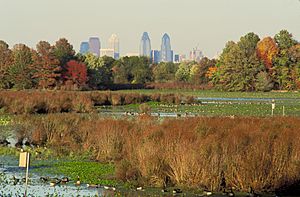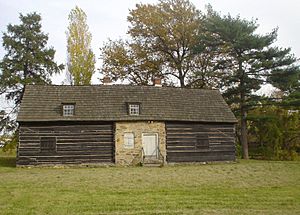John Heinz National Wildlife Refuge at Tinicum facts for kids
Quick facts for kids John Heinz National Wildlife Refuge at Tinicum |
|
|---|---|
|
IUCN Category IV (Habitat/Species Management Area)
|
|
| Location | Delaware County and Philadelphia County, Pennsylvania, USA |
| Nearest city | Philadelphia, Pennsylvania |
| Area | 1,200 acres (4.9 km2) |
| Established | 1972 |
| Governing body | U.S. Fish and Wildlife Service |
| Website | John Heinz National Wildlife Refuge at Tinicum |
| Designated: | 1965 |
The John Heinz National Wildlife Refuge at Tinicum is a special natural area. It covers about 1,000 acres (4.05 km2) of land. This refuge is located in both Philadelphia and Delaware counties in Pennsylvania. It's right next to the Philadelphia International Airport.
This important place was created in 1972. It was first called the Tinicum National Environmental Center. Later, in 1991, it was renamed to honor H. John Heinz III. He was a senator who worked hard to protect this area. The refuge's main job is to protect the largest freshwater tidal marsh in Pennsylvania. This marsh covers about 350 acres (0.8 km2). When all the planned land is bought, the refuge will be 1,200 acres (4.9 km2). It will have many different types of natural homes for animals and plants.
Contents
History of Tinicum Marsh: A Natural Treasure

The story of Tinicum Marsh began a long time ago, around 1634. This was when the first settlers arrived in the area. Dutch, Swedish, and English settlers changed parts of the marsh. They built dikes and drained land for their animals to graze. Back then, the huge tidal marshes covered over 5,700 acres (23 km2).
After World War I, cities grew very quickly. This caused the tidal marshes to shrink a lot. Today, only about 200 acres (0.8 km2) of the original marsh remain. The John Heinz National Wildlife Refuge protects this important piece of nature.
In 1955, a part of the marsh was given to the City of Philadelphia. This area was 145 acres (0.6 km2) and was not affected by tides. It was called the Tinicum Wildlife Preserve. This area had open water and thick wetlands. It was a perfect home for thousands of birds that migrate.
The marsh was recognized as a National Natural Landmark in 1965. But in 1969, it faced new threats. There were plans to build Interstate 95 right through it. Also, a landfill was planned for the tidal wetlands. Many groups and people worked together to save the marsh. They held public meetings and took legal action. Their efforts helped change the highway's path, which was finished in 1985. They also stopped the landfill.
One of the groups was The Philadelphia Conservationists. These bird watchers helped protect the Tinicum marshes. They later formed Natural Lands Trust in 1961. This group still works to save natural areas in Pennsylvania and New Jersey. In 1972, the U.S. Congress passed a law. This law allowed the government to buy 1,200 acres (4.9 km2). This land would become the Tinicum National Environmental Center. In 1991, the refuge was renamed. It became the John Heinz National Wildlife Refuge at Tinicum. This was to honor Senator John Heinz, who helped protect this special marsh.
Exploring the Refuge: Habitats and Wildlife
The refuge has five different types of natural areas. These are:
- Freshwater tidal marsh
- Areas of impounded water (water held back by a barrier)
- Woods
- Meadows
- Open fields
Having so many different habitats in one place makes it a great spot for wildlife. Many kinds of fish live in Darby Creek. This creek is very important to Tinicum Marsh. Fish also live in the 145-acre (0.6 km2) impoundment and Hoy's Pond. You can find fish like brown bullhead, channel catfish, crappie, and carp. Young striped bass also use Darby Creek before it flows into the Delaware River. The fields and meadows are full of wildflowers. Many insects, including different types of butterflies, visit these flowers.
Amazing Birds and Migratory Journeys
Even though the refuge is in a city, it's home to lots of wildlife. Birdwatchers have seen over 300 types of birds here. About 85 of these birds even build their nests at the refuge. Many migratory birds use the refuge as a resting and feeding spot. These birds include warblers, egrets, sandpipers, and many kinds of ducks. They travel along the Atlantic Flyway during spring and fall.
The refuge can control the water levels in the impoundment. In early fall, the water is often drained. This helps reduce the number of invasive carp. It also turns the impoundment into a large mudflat. This is very attractive to migrating shorebirds. Later in the fall, the water levels are raised. This allows waterfowl (ducks, geese, etc.) to use the impoundment.
Other Animals Living at the Refuge
Besides birds, many other animals live here. You might see deer, opossums, red foxes, and raccoons. There are also coyotes, beavers, and river otters. Other residents include minks, woodchucks, and muskrats. The refuge also protects many types of wildflowers and plants.
Bats are often seen during warmer months. Scientists want to study them more. This will help understand why bat populations are decreasing. Problems like white-nose syndrome and habitat loss are affecting them.
Many reptiles and amphibians also call the refuge home. These include:
- Snakes: northern water, garter, and Northern brown snakes.
- Frogs: pickerel, wood, and southern leopard frogs. The southern leopard frog is endangered in Pennsylvania.
- Turtles: The state-threatened American red-bellied turtle. Also, painted, snapping, and eastern box turtles.
Climate: Weather at the Refuge
The John Heinz National Wildlife Refuge has a changing climate. It's between a cooler Continental climate to the north and a warmer Humid subtropical climate to the south. The weather here is like a Temperate Oceanic climate. This means it has hot summers and cool winters. It also gets rain all year long.
Most summer days are a bit humid. But sometimes it can get very hot and humid. The highest temperature recorded since 1981 was 102.9°F (39.4°C) on July 22, 2011. The wettest month is July, when thunderstorms are most common. The most rain in one day was 6.58 inches (167 mm) on August 27, 2011.
In winter, the coldest temperature recorded since 1981 was -5.8°F (-21.0°C) on January 22, 1984. Sometimes, it can get very cold and windy. Ice storms and big snowstorms (12 inches or more) happen every few years. These often occur from December to February during storms called nor’easters.
| Climate data for John Heinz National Wildlife Refuge at Tinicum Visitor Center. 1981-2010 Averages (1981-2018 Records). | |||||||||||||
|---|---|---|---|---|---|---|---|---|---|---|---|---|---|
| Month | Jan | Feb | Mar | Apr | May | Jun | Jul | Aug | Sep | Oct | Nov | Dec | Year |
| Record high °F (°C) | 71.7 (22.1) |
77.4 (25.2) |
85.6 (29.8) |
94.0 (34.4) |
95.2 (35.1) |
97.9 (36.6) |
102.9 (39.4) |
100.5 (38.1) |
98.9 (37.2) |
88.8 (31.6) |
81.4 (27.4) |
74.2 (23.4) |
102.9 (39.4) |
| Mean daily maximum °F (°C) | 40.6 (4.8) |
44.2 (6.8) |
52.3 (11.3) |
63.6 (17.6) |
73.6 (23.1) |
82.9 (28.3) |
87.2 (30.7) |
85.5 (29.7) |
78.5 (25.8) |
67.0 (19.4) |
56.1 (13.4) |
45.1 (7.3) |
64.8 (18.2) |
| Daily mean °F (°C) | 33.7 (0.9) |
36.6 (2.6) |
43.8 (6.6) |
54.4 (12.4) |
64.2 (17.9) |
73.7 (23.2) |
78.5 (25.8) |
77.0 (25.0) |
69.6 (20.9) |
58.2 (14.6) |
48.3 (9.1) |
38.3 (3.5) |
56.5 (13.6) |
| Mean daily minimum °F (°C) | 26.8 (−2.9) |
29.0 (−1.7) |
35.3 (1.8) |
45.2 (7.3) |
54.8 (12.7) |
64.5 (18.1) |
69.7 (20.9) |
68.5 (20.3) |
60.6 (15.9) |
49.5 (9.7) |
40.4 (4.7) |
31.5 (−0.3) |
48.1 (8.9) |
| Record low °F (°C) | −5.8 (−21.0) |
1.7 (−16.8) |
6.4 (−14.2) |
20.3 (−6.5) |
37.5 (3.1) |
46.7 (8.2) |
53.3 (11.8) |
46.8 (8.2) |
40.5 (4.7) |
29.8 (−1.2) |
15.9 (−8.9) |
2.3 (−16.5) |
−5.8 (−21.0) |
| Average precipitation inches (mm) | 3.27 (83) |
2.71 (69) |
3.94 (100) |
3.73 (95) |
3.85 (98) |
3.85 (98) |
4.58 (116) |
3.89 (99) |
4.08 (104) |
3.51 (89) |
3.26 (83) |
3.74 (95) |
44.41 (1,128) |
| Average snowfall inches (cm) | 6.5 (17) |
8.8 (22) |
2.9 (7.4) |
0.5 (1.3) |
0.0 (0.0) |
0.0 (0.0) |
0.0 (0.0) |
0.0 (0.0) |
0.0 (0.0) |
0.0 (0.0) |
0.3 (0.76) |
3.4 (8.6) |
22.4 (57) |
| Average relative humidity (%) | 64.8 | 59.4 | 56.9 | 56.4 | 59.9 | 62.5 | 63.8 | 64.9 | 66.9 | 66.5 | 64.5 | 64.0 | 62.6 |
| Average dew point °F (°C) | 23.1 (−4.9) |
23.8 (−4.6) |
29.5 (−1.4) |
39.2 (4.0) |
50.0 (10.0) |
60.1 (15.6) |
65.2 (18.4) |
64.3 (17.9) |
58.1 (14.5) |
47.1 (8.4) |
36.9 (2.7) |
27.2 (−2.7) |
43.8 (6.6) |
| Source: PRISM | |||||||||||||
Visitor Activities and Facilities
The refuge offers many ways for visitors to enjoy nature.
Trails for Walking and Exploring
There are over 10 miles (16 km) of trails to explore. A popular one is the "Impoundment Trail." There are also two boardwalks. These cross the impoundment and a smaller cove. Some parts of the trails are part of the East Coast Greenway. This is a huge trail system, 3,000 miles long, connecting Maine to Florida.
Canoeing on Darby Creek
You can canoe for about 4.5 miles (7.2 km) on Darby Creek. This part of the creek flows right through the refuge. It's a great way to see different plants and animals from the water.
Along the creek's deep water lagoon, you might see:
- The Sun Oil Company's tank farm.
- The old Delaware County Sewer Treatment Plant.
- Action Concrete's recycling operation.
- The 62-acre (250,000 m2) Folcroft Landfill. This landfill was active from 1956 to 1974. Now it's covered and watched carefully.
- The historic Morton Mortensen House. This house is in Norwood's Winona Park. It was built in the early 1700s. It's thought to be the oldest building made by people in Pennsylvania.
Fishing Opportunities
Fishing is allowed along the main dike trail and the Trolley Bed trail. Here, you can fish in the 145-acre (0.6 km2) impoundment and Darby Creek. Common fish caught here are carp, catfish, large-mouth bass, and smaller panfish.
Another fishing spot is near Tinicum and Prospect Park. This area is on the west side of Route 420. It gives access to the lagoon areas of the Refuge. You might catch striped bass, carp, catfish, panfish, and tiger musky here. However, because the refuge is in a city, the creek has some pollution. Signs are in place to tell people not to eat the fish from the stream.




